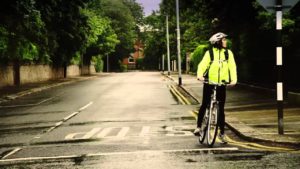
Ensure your bike is roadworthy
Regularly check your brakes and tyre pressure. Don’t ignore any strange noises, vibrations, or jumping gears – they usually indicate a problem.
Know how to control your bike
Learn how to shift your body weight when making an emergency stop, be able to swerve safely, use your gears properly, control the bike while looking directly behind and confidently ride with one hand. On the road, ride with at least two of your fingers on your brake levers.
Don’t be afraid to use roads
Cycling in parks and on cycle paths is great fun, but being able to use the road gives you the freedom cycling was intended to give you. Cycling on the pavement, even considerately, is against the law. If you are nervous about cycling on the road, get training.
Know how to position yourself in traffic
Ride away from the kerb, never in the gutter, and at least a car-door’s width away from parked cars. Ride in the stream of traffic when you can match its speed. If you have to ride close to slower moving traffic or parked cars (for example on a narrow road), do so slowly so you have time to react to hazards (such as an opening door).
Remember to look behind you
Check behind yourself frequently, especially before changing position on the road. This attracts the attention of drivers as well as ensuring that you know what is happening around you.
Ensure good road communication
Communicate your intentions with hand signals and correct road positioning. Don’t signal without looking behind first – it may be unsafe.
Know how to approach junctions
Arrive at junctions in the middle of your lane, whether you are turning left or right or going straight ahead. This prevents dangerous overtaking from traffic behind. At traffic lights the least safe option is to undertake (on the left), so either wait your turn or consider overtaking (on the right) to get to the front before pulling in to the stream of traffic when it starts moving.
Know how to approach roundabouts
Arrive at, and move through, roundabouts in the middle of the most appropriate lane.
Be aware of large vehicles
Never cycle on the kerb side of any large vehicle at a junction – if you’re in the driver’s “blind spot”, they won’t be able to see you if they turn left. Always maintain enough distance behind or in front of any large vehicle so the driver can see you. If you can’t see the mirrors, the driver probably can’t see you.
Get some cycle training
If you are unsure about any of the points above, go on a training course. Check with your local authority for any subsidised or even free training opportunities they might offer.
